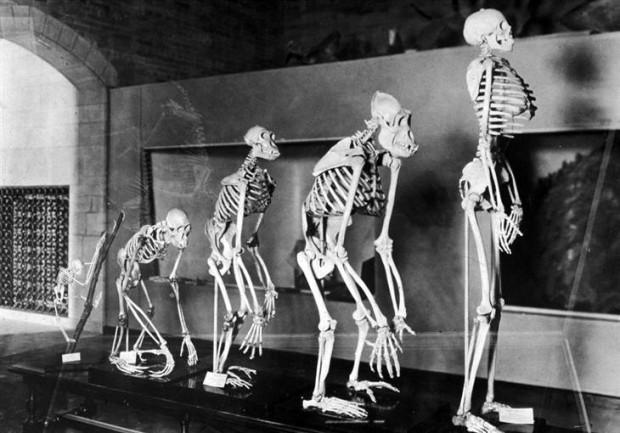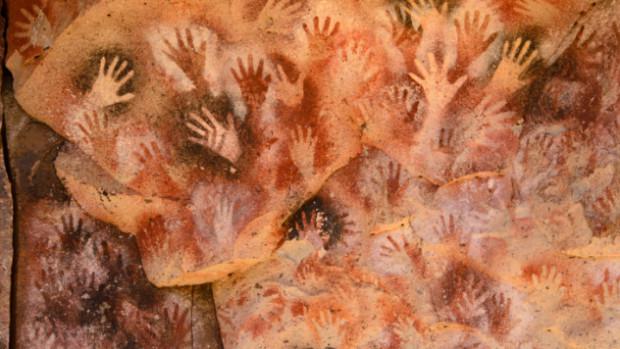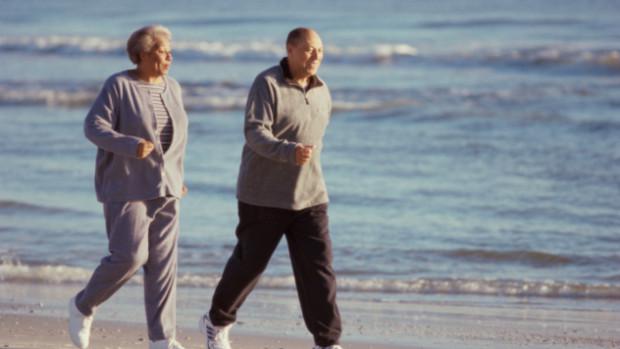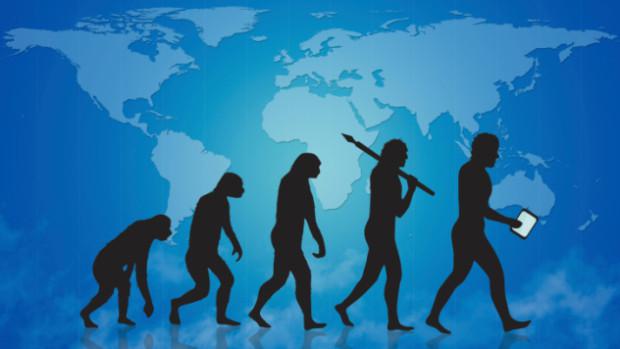The strangeness of human evolution
 Bashny.Net
Bashny.Net
As scientists continue to explore our evolutionary history, there are new facts which explain how the past shapes the modern people, the size of our brain to the length of life. Even more intriguing is the role played by accident in the formation of the brain and body, which have modern humans.

1. The human person is formed so as to withstand the impact

Until recently, it was widely believed that strong human faces formed about four to five million years ago, to help our ancestors Australopithecus chew solid food, such as nuts. But now this opinion destroyed by a punch in the face.
According to a study at the University of Utah, our distant past was not as peaceful as we once thought. Probably violence played a much greater role in the development of human physiology than we suspected before. Researchers believe that men's faces are formed in such a way as to minimize the risk of injury from blows during fights for women, food and territory. Facial bones become stronger, so as not to break during the melee. These bones represent the difference between male and female skull. Obviously, male individuals had to evolve in such a way because the bones breaking in combat, men are larger.
If this theory is correct, people were not noble savages, have become aggressive due to civilization. Instead, our physical ability to develop, to improve our fighting force.
2. Human hands have evolved to strike

While human faces formed to withstand the blow, our hands were formed for its application. In an earlier study of the same University of Utah scientists discovered that human hands formed paradoxically. In comparison with the monkeys, the same features that allow us clenched fist - short four fingers and palm with a long, strong and flexible thumb - also give us agility to make and use the fine instruments. But while chimps can make instruments, they can not compress fists.
It is also possible that our hands have evolved from the same gene that gave us a short toes and elongated thumb, when we started to walk and run in a vertical position.
Scientists believe that our aggressive and violent nature made our bodies turn into fighting machines. A man stabbing a clenched fist can hit harder, do not hurt yourself. Fists can also be used for intimidation. Ultimately, our hands - as to their ability to kill, and to create - can share good and evil in human nature.
3. We had herpes before we became people

Some physical characteristics of our developed not just for a long time. Some diseases, such as herpes, came to us from chimpanzees.
Approximately 67% of the modern people have at least one herpes simplex virus (HSV). In fact, people - the only primates that have two HSV, usually manifested in the form of herpes on the lips or blisters on the genitals. Herpes first type affected people before they split from chimpanzees about six million years ago. HSV second type to us from chimps about 1, 6 million years ago. Scientists from the University of California believe that the study of the origin of these viruses will help prevent the transition to people of other diseases.
Another group of scientists from Oxford and the University of Plymouth found ancient viruses Neanderthals in modern human DNA. These viruses occur from a family HML2 and can be linked to cancer and HIV modern man. This information may be useful in the future for the development of therapies.
4. Man - the only primate teeth whose size decreases with increasing brain size

During the last 2 to 5 million years were associated with two tendencies of human development - the size of the human brain increased and decreased the size of the teeth. We - the only primates that can make that claim.
Usually when the brain is growing, growing and teeth, because the body needs more energy from food. Therefore, scientists call what happened to the people, an evolutionary paradox. They believe that it is derived from the fact that people are eating more meat, which nourishes our brains.
Also, the people - the only primates who have developed thick tooth enamel. In herbivorous primates tooth enamel is thin, in higher primates and monkeys that eat both plants and animals, the average thickness of the enamel. Do people even more thick enamel, likely to push hard foods. Scientists human enamel can also determine the age and diet of ancient people in human fossils.
And Neanderthals - the oldest hominids enjoyed toothpicks to ease the pain of dental diseases, such as tenderness of the gums.
5. Our overall male and female ancestors lived about the same time

Researchers often use the name «Y-chromosomal Adam" for our most recent common ancestor. Males usually have one X-chromosome and one Y-chromosome, women - two X-chromosomes.
According to a study published in the "European Journal of Human Genetics", "Adam" probably lived about 209,000 years ago.
This model is contrary to previous research by the University of Arizona, suggested that the Y-chromosome existed before the origins of humanity. Scientists from Arizona believed that the Y-chromosome modern men were created by crossing species more than 500 thousand years ago. But the authors of the new study say that Arizona study, if properly interpreted, creates a "space-time paradox, according to which the oldest individuals belonging mind Homo Sapiens, not yet born».
The new study also puts Y-chromosome "Adam" during the "Eve" of the nearest female common ancestor of modern humans. However, scientists claim that there was no one "Adam" and one "Eve" - instead of them were groups of "Adam" and "EB" roaming the world.
6. Grandparents help us live longer

Grandmother made us who we are. This conclusion was made by scientists from the University of Utah, who ran computer simulations to test the famous "grandmother hypothesis". According to the theory of evolution, humans duration of life than in monkeys, because my grandmother helped feed her grandchildren. Other primates themselves looking for their own food after weaning.
When human grandmother began to help feed their grandchildren, mothers were able to have more children. The simulation showed that the evolution of the women who die immediately after child-bearing age, living up to a decade after menopause took 60,000 years.
Many anthropologists believe that the increase in the size of our brain helped to increase the duration of our lives. However, researchers from Utah to control the size of the brain, hunting and pairings in computer simulation. When they entered a minimal effect on the presence of her grandmother, the human life span has increased dramatically. Scientists have come to the conclusion that my grandmother helped - or even caused - such important changes in human evolution, brain development as larger social dependence and our tendency to work together.
7. The protein could contribute to the development of the brain larger

Researchers from the University of Colorado have another theory about why the human brain has evolved so quickly to such a size and complex system. These researchers found that the domain of the protein, which is a specific unit of the protein structure, in more common in men than in animals. This protein domain DUF1220, and what it is, the more your brain. People in the genome has 270 copies, followed by chimpanzees and gorillas from 125 to 99 copies. In mice, there is only one copy. This means that the brain size may vary depending on the amount of protein domain.
Also contribute to the development of the brain of large size have difficulty finding rare insects for food, which required the development of problem-solving skills and tools. But the larger brain size was not the only factor in the evolution of man from the primacy - people are also more complex genetic activity that helps in learning.
8. Throwing made us human

Throwing skills of modern baseball evolved from our extinct human ancestors. Early humans learned to throw stones and sharpened wooden spear while hunting almost two million years ago. According to scientists from George Washington University and Harvard University, even chimpanzees can not compete with the people in these skills. Chimpanzees can at best throw only one-third as fast as the 12-year-old Little League pitcher.
The researchers wanted to find out why people give up so well. While watching a baseball game recording scientists realized that the human arm works like a slingshot, retaining and releasing energy during the throw. Some features of the human torso, shoulder and arm specially developed to help us to store this energy.
Throwing skills have allowed our ancestors to kill and eat the big game. Eating meat has stimulated the development of the human body and brain to large sizes. So the unique ability of our ancestors to throwing helped us become human.
9. The duration of a person's life may be associated with an extremely slow metabolism

Humans and other primates burned 50% fewer calories than other mammals. This means that in order to burn as many calories as burn other mammals of the same size for a day, a person will have to run a marathon.
According to a new study, to explain why we are growing so slowly, so rarely have children and live so long, can we slow our metabolism. It may also explain why we have developed so many different programs for weight loss. But if you exercise, and you have a problem with weight loss, the study can also point you to the cause. It was also found that the primates in cages at the zoo spent as much energy as their counterparts in the wild, and this in turn means that physical activity is likely to affect the amount of burned calories less per day than we thought.
For comparison, the majority of mammals, such as our domestic dogs or hamsters, quickly go through all stages of life and early death - often after a decade or earlier. Scientists believe that environmental conditions have affected the development of slow metabolism, which gives us a long life.
10. The irony that influenced human evolution

Scientists from the University of Chicago are engaged in "molecular time travel 'to see how human evolution could have gone differently. They started with an important protein in the human body, as it existed hundreds of millions of years ago. This protein, eventually became the cellular receptor for the stress hormone cortisol.
Biologists want to know how this ancient protein became sensitive to cortisol. After studying thousands of alternate versions, they found only one answer - it was an accident. Should have happened two extremely rare mutation, so that the protein could develop sensitivity to cortisol. In other words, the modern form of the protein occurred due to chance in our distant past.
Researchers believe that a series of unlikely chance events - irony - influenced the proteins that make us who we are. If proteins evolve new functions, it is possible to explain the diversity and genetic diversity of life. It also means that some other circumstances, people could turn into something completely different.

1. The human person is formed so as to withstand the impact

Until recently, it was widely believed that strong human faces formed about four to five million years ago, to help our ancestors Australopithecus chew solid food, such as nuts. But now this opinion destroyed by a punch in the face.
According to a study at the University of Utah, our distant past was not as peaceful as we once thought. Probably violence played a much greater role in the development of human physiology than we suspected before. Researchers believe that men's faces are formed in such a way as to minimize the risk of injury from blows during fights for women, food and territory. Facial bones become stronger, so as not to break during the melee. These bones represent the difference between male and female skull. Obviously, male individuals had to evolve in such a way because the bones breaking in combat, men are larger.
If this theory is correct, people were not noble savages, have become aggressive due to civilization. Instead, our physical ability to develop, to improve our fighting force.
2. Human hands have evolved to strike

While human faces formed to withstand the blow, our hands were formed for its application. In an earlier study of the same University of Utah scientists discovered that human hands formed paradoxically. In comparison with the monkeys, the same features that allow us clenched fist - short four fingers and palm with a long, strong and flexible thumb - also give us agility to make and use the fine instruments. But while chimps can make instruments, they can not compress fists.
It is also possible that our hands have evolved from the same gene that gave us a short toes and elongated thumb, when we started to walk and run in a vertical position.
Scientists believe that our aggressive and violent nature made our bodies turn into fighting machines. A man stabbing a clenched fist can hit harder, do not hurt yourself. Fists can also be used for intimidation. Ultimately, our hands - as to their ability to kill, and to create - can share good and evil in human nature.
3. We had herpes before we became people

Some physical characteristics of our developed not just for a long time. Some diseases, such as herpes, came to us from chimpanzees.
Approximately 67% of the modern people have at least one herpes simplex virus (HSV). In fact, people - the only primates that have two HSV, usually manifested in the form of herpes on the lips or blisters on the genitals. Herpes first type affected people before they split from chimpanzees about six million years ago. HSV second type to us from chimps about 1, 6 million years ago. Scientists from the University of California believe that the study of the origin of these viruses will help prevent the transition to people of other diseases.
Another group of scientists from Oxford and the University of Plymouth found ancient viruses Neanderthals in modern human DNA. These viruses occur from a family HML2 and can be linked to cancer and HIV modern man. This information may be useful in the future for the development of therapies.
4. Man - the only primate teeth whose size decreases with increasing brain size

During the last 2 to 5 million years were associated with two tendencies of human development - the size of the human brain increased and decreased the size of the teeth. We - the only primates that can make that claim.
Usually when the brain is growing, growing and teeth, because the body needs more energy from food. Therefore, scientists call what happened to the people, an evolutionary paradox. They believe that it is derived from the fact that people are eating more meat, which nourishes our brains.
Also, the people - the only primates who have developed thick tooth enamel. In herbivorous primates tooth enamel is thin, in higher primates and monkeys that eat both plants and animals, the average thickness of the enamel. Do people even more thick enamel, likely to push hard foods. Scientists human enamel can also determine the age and diet of ancient people in human fossils.
And Neanderthals - the oldest hominids enjoyed toothpicks to ease the pain of dental diseases, such as tenderness of the gums.
5. Our overall male and female ancestors lived about the same time

Researchers often use the name «Y-chromosomal Adam" for our most recent common ancestor. Males usually have one X-chromosome and one Y-chromosome, women - two X-chromosomes.
According to a study published in the "European Journal of Human Genetics", "Adam" probably lived about 209,000 years ago.
This model is contrary to previous research by the University of Arizona, suggested that the Y-chromosome existed before the origins of humanity. Scientists from Arizona believed that the Y-chromosome modern men were created by crossing species more than 500 thousand years ago. But the authors of the new study say that Arizona study, if properly interpreted, creates a "space-time paradox, according to which the oldest individuals belonging mind Homo Sapiens, not yet born».
The new study also puts Y-chromosome "Adam" during the "Eve" of the nearest female common ancestor of modern humans. However, scientists claim that there was no one "Adam" and one "Eve" - instead of them were groups of "Adam" and "EB" roaming the world.
6. Grandparents help us live longer

Grandmother made us who we are. This conclusion was made by scientists from the University of Utah, who ran computer simulations to test the famous "grandmother hypothesis". According to the theory of evolution, humans duration of life than in monkeys, because my grandmother helped feed her grandchildren. Other primates themselves looking for their own food after weaning.
When human grandmother began to help feed their grandchildren, mothers were able to have more children. The simulation showed that the evolution of the women who die immediately after child-bearing age, living up to a decade after menopause took 60,000 years.
Many anthropologists believe that the increase in the size of our brain helped to increase the duration of our lives. However, researchers from Utah to control the size of the brain, hunting and pairings in computer simulation. When they entered a minimal effect on the presence of her grandmother, the human life span has increased dramatically. Scientists have come to the conclusion that my grandmother helped - or even caused - such important changes in human evolution, brain development as larger social dependence and our tendency to work together.
7. The protein could contribute to the development of the brain larger

Researchers from the University of Colorado have another theory about why the human brain has evolved so quickly to such a size and complex system. These researchers found that the domain of the protein, which is a specific unit of the protein structure, in more common in men than in animals. This protein domain DUF1220, and what it is, the more your brain. People in the genome has 270 copies, followed by chimpanzees and gorillas from 125 to 99 copies. In mice, there is only one copy. This means that the brain size may vary depending on the amount of protein domain.
Also contribute to the development of the brain of large size have difficulty finding rare insects for food, which required the development of problem-solving skills and tools. But the larger brain size was not the only factor in the evolution of man from the primacy - people are also more complex genetic activity that helps in learning.
8. Throwing made us human

Throwing skills of modern baseball evolved from our extinct human ancestors. Early humans learned to throw stones and sharpened wooden spear while hunting almost two million years ago. According to scientists from George Washington University and Harvard University, even chimpanzees can not compete with the people in these skills. Chimpanzees can at best throw only one-third as fast as the 12-year-old Little League pitcher.
The researchers wanted to find out why people give up so well. While watching a baseball game recording scientists realized that the human arm works like a slingshot, retaining and releasing energy during the throw. Some features of the human torso, shoulder and arm specially developed to help us to store this energy.
Throwing skills have allowed our ancestors to kill and eat the big game. Eating meat has stimulated the development of the human body and brain to large sizes. So the unique ability of our ancestors to throwing helped us become human.
9. The duration of a person's life may be associated with an extremely slow metabolism

Humans and other primates burned 50% fewer calories than other mammals. This means that in order to burn as many calories as burn other mammals of the same size for a day, a person will have to run a marathon.
According to a new study, to explain why we are growing so slowly, so rarely have children and live so long, can we slow our metabolism. It may also explain why we have developed so many different programs for weight loss. But if you exercise, and you have a problem with weight loss, the study can also point you to the cause. It was also found that the primates in cages at the zoo spent as much energy as their counterparts in the wild, and this in turn means that physical activity is likely to affect the amount of burned calories less per day than we thought.
For comparison, the majority of mammals, such as our domestic dogs or hamsters, quickly go through all stages of life and early death - often after a decade or earlier. Scientists believe that environmental conditions have affected the development of slow metabolism, which gives us a long life.
10. The irony that influenced human evolution

Scientists from the University of Chicago are engaged in "molecular time travel 'to see how human evolution could have gone differently. They started with an important protein in the human body, as it existed hundreds of millions of years ago. This protein, eventually became the cellular receptor for the stress hormone cortisol.
Biologists want to know how this ancient protein became sensitive to cortisol. After studying thousands of alternate versions, they found only one answer - it was an accident. Should have happened two extremely rare mutation, so that the protein could develop sensitivity to cortisol. In other words, the modern form of the protein occurred due to chance in our distant past.
Researchers believe that a series of unlikely chance events - irony - influenced the proteins that make us who we are. If proteins evolve new functions, it is possible to explain the diversity and genetic diversity of life. It also means that some other circumstances, people could turn into something completely different.
Tags
See also
Interestnye animals
Unexplained mysteries
10 interesting facts about the person
Artistic presentation of a real case
Counter-Strike
Found evidence that viruses are living organisms
Women John Mayer
Travel Novosibirsk - Karelia for Opel Vectra
Peter Watts: collective consciousness
10 jobs for physicians of the future

















